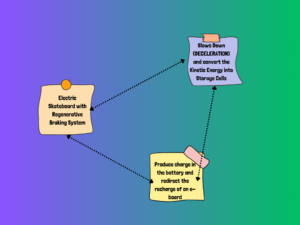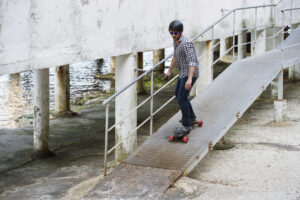“An energy cannot be lost, it can only be transformed.” In traditional braking i.e. Friction Braking System, the energy is transformed into heat energy.
Regenerative braking plays a very important role in electric skateboards. It’s an ‘energy recovery system’ that creates electricity from the vehicle’s kinetic energy that would normally be lost as heat from the brakes. The electricity produced would then be used to recharge the battery. In simple terms, normal braking uses friction, with the brake calipers pressing on the disks. This process produces kinetic energy which would be lost.
This is such a useful and convenient trick. Just think of how often you’re stopping and starting in a city environment. In this situation, an electric skateboard can recover lots of energy, reducing energy consumption drastically.
HOW EXACTLY DOES ENERGY RECOVERY WORK?
Without getting too technical, energy recovery occurs by inverting your electric motor’s method of operation. When you’re driving, the engine uses the energy contained in the battery to move the wheels. However, when decelerating or braking, the motor acts as a generator, transforming the kinetic energy that would be lost as heat, into electricity.
An electric motor contains two key components: the stator and the rotor. The stator is the stationary part and contains a type of frame that has wires coiled around it. Electric current circulates within this frame. So it creates a magnetic field that rotates.
The rotor, instead, is the mobile part of the motor. This is inserted into the stator and is also equipped with wires or magnetic that create a magnetic field. The interaction between the two magnetic fields makes the rotor move. Since it’s attached to the transmission, it provides the torque required to make the wheels turn.
When a vehicle brakes or decelerates, the electric motor works the opposite way, transforming it into a sort of generator. So, instead of consuming energy, it produces it. As we said, the current produced is then used to recharge the accumulator.
Thanks to regenerative braking, you’re not just slowing the electric skateboard down, you’re also charging the battery.
THE ADVANTAGES OF REGENERATIVE BRAKING
Since the traditional brakes would be used less, they’ll suffer less wear and tear.
Through the remote, you can “play” with the level of regenerative braking. In this way, in addition to managing the intensity of energy recovery, you can also adjust the “force” with which the skateboard decelerates.
By properly using energy recovery, the range of the electric skateboard can be improved. It is good to know that if the battery is 100% charged or if the accumulator has not reached optimal operating temperature (this is especially the case in winter), regenerative braking may not be as effective. It is important to remember this, although over time you gradually learn to handle it in all conditions.
Regenerative Braking and Sustainable Development
As we all know, to control global warming almost all of the countries in the world are working on climate and sustainable development. Regenerative braking is one of the “R” of 3Rs of the sustainable development initiative. Here “R” stands solely for reuse and recreation of the available sources.
In regenerative braking, the energy is reused by the battery and recharges the cells of the battery. In this way, whenever the rider brakes, the battery gets recharged. Hence regenerative braking system contributes clearly to the sustainability of the products.
Whenever you plan to buy an electric skateboard, prefer the one that comes with regenerative braking. Because the regenerative braking system has changed the concept of electric skateboarding and its complications.




